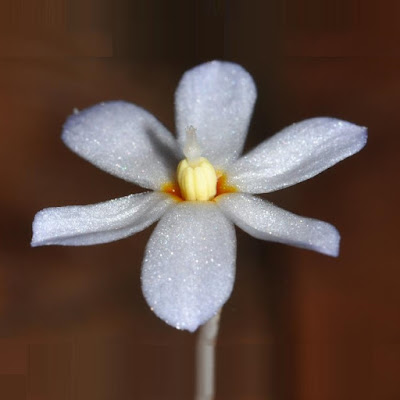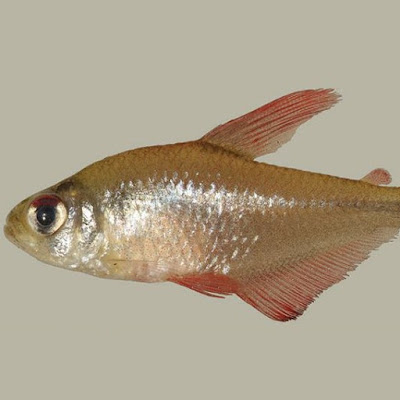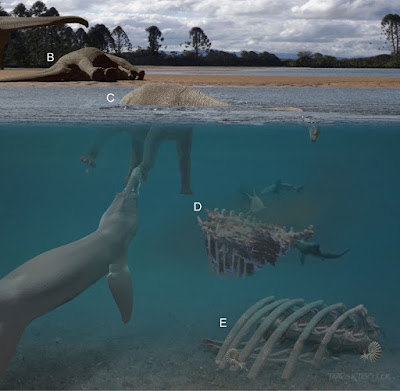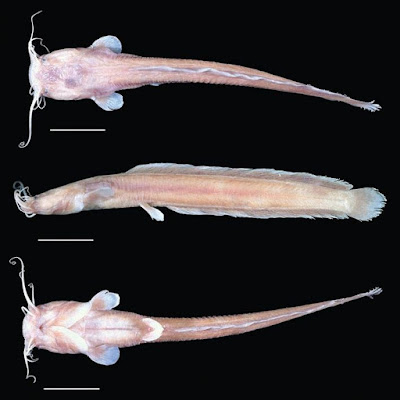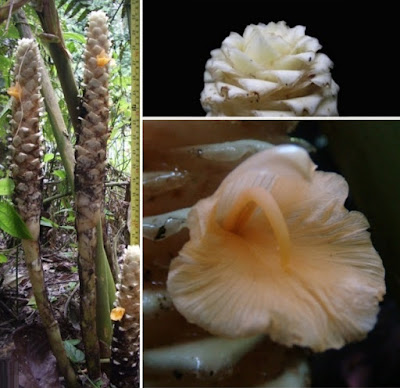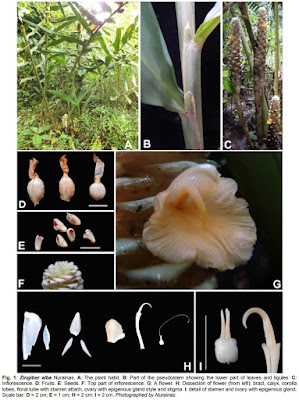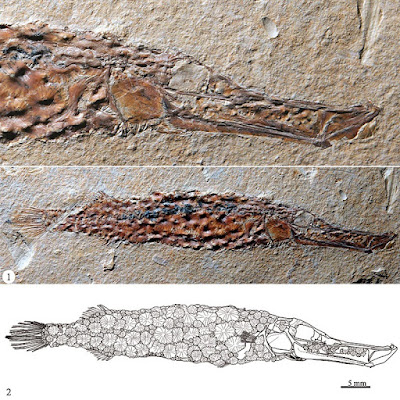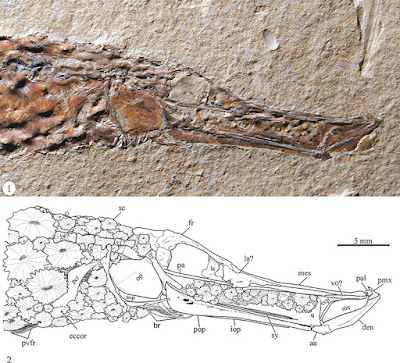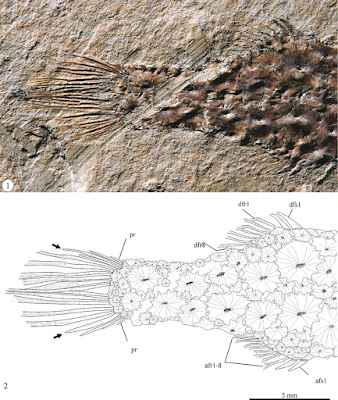[Most Recent Entries] [Calendar View]
Saturday, July 29th, 2017
| Time | Event | ||||
| 11:04a | [Crustacea • 2017] On the Identities of The Highland Vampire Crabs, Geosesarma foxi (Kemp, 1918) and G. serenei Ng, 1986 (Decapoda: Brachyura: Sesarmidae), with Description of A New Phytotelmic Species, Geosesarma faustum, from Penang, Peninsular Malaysia Abstract The identities of two poorly known semiterrestrial sesarmid crabs Geosesarma foxi (Kemp, 1918) and G. serenei Ng, 1986, from northern Peninsular Malaysia are clarified with the study of additional material. A new species associated with phytotelms in Penang, Geosesarma faustum n. sp., is described and distinguished from the two known species by various carapace, male pleon and gonopod characters. The taxonomy of the three species is discussed. All three are highland species, occurring only at altitudes higher than 700 m; and are characterised by their quadrate carapace, long and slender ambulatory legs, absence of a flagellum on the exopod of their third maxilliped, and relatively slender male first gonopod. Key words: Phytotelmata, Southeast Asia, Sesarmidae, montane crabs, Geosesarma, taxonomy, new taxa Peter K. L. Ng. 2017. On the Identities of The Highland Vampire Crabs, Geosesarma foxi (Kemp, 1918) and G. serenei Ng, 1986, with Description of A New Phytotelmic Species from Penang, Peninsular Malaysia (Crustacea: Decapoda: Brachyura: Sesarmidae). RAFFLES BULLETIN OF ZOOLOGY. 65: 226–242.  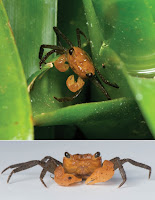 | ||||
| 11:55a | [Botany • 2017] Geosiris australiensis • First Record of Geosiris (Iridaceae: Geosiridoideae) from Australasia : A New Record and A New Species from the Wet Tropics of Queensland, Australia
Geosiris Baill. is a small genus of achlorophyllous, mycoheterotrophic herbs that until now consisted of only two species, Geosiris albiflora Goldblatt & J.C. Manning and Geosiris aphylla Baill., the latter being the type species of the genus. Prior to this study, the genus was known only from two islands off the southeast coast of Africa, Madagascar and Mayotte. A recent discovery in Australia reported here expands its geographic range to the Pacific. The Australian taxon represents a species distinct from the two African taxa based on the key morphological characters for species distinction in the genus, namely stigma characteristics. Geosiris albiflora has a somewhat club-like stigma with three coherent lobes, Geosiris aphylla with a stigma terminates in three fringed broad and flat stigmatic lobes, and the Australian Geosiris has a truncate stigma with a short fimbriate margin. Hence, the Australian taxon is formally described here as Geosiris australiensis B. Gray & Y.W. Low. Keywords: Iridaceae, Geosiris, Australia, Queensland, Taxonomy, Mycoheterotrophy, New generic record, New species Geosiris australiensis B. Gray & Y.W. Low, spec. nova Etymology. – The species epithet refers to Australia, as it is the first generic record for the continent. Distribution and habitat. – Geosiris australiensis is only known from the tropical rainforests of north-east Queensland, Australia. The only known specimens were growing on a moist forest floor covered with thick organic litter under shaded conditions in the Daintree National Park, a UNESCO World Heritage site. Bruce Gray and Yee Wen Low. 2017. First Record of Geosiris (Iridaceae: Geosiridoideae) from Australasia : A New Record and A New Species from the Wet Tropics of Queensland, Australia. Candollea. 72(2); 249-255. DOI: 10.15553/c2017v722a2 Scientists in a spin over discovery of new flower species in Daintree | ||||
| 3:07p | [Ichthyology • 2017] Hyphessobrycon platyodus • A New Species (Teleostei: Characiformes) from the Rio Madeira Nasin, Brazil, with Comments on How Multicuspid Teeth Relate to Feeding Habits in Characidae
Abstract A new species of Hyphessobrycon is described from the Rio Juma, a tributary of the lower Rio Aripuanã–Rio Madeira basin, Amazonas, Brazil. Hyphessobrycon platyodus can be distinguished from its congeners by the: presence of an elongated dorsal fin in adult males, 25–28 branched anal-fin rays and absence of dark blotches from the dorsal fin and caudal peduncle. The presence of multicuspid teeth in species of Characidae and its relation with feeding habits are briefly commented on. Key words: Amazon; endemism; Hyphessobrycon loweae-group; sexual dimorphism; tooth cusps.
Etymology: The specific epithet platyodus derives from the Greek, platy, flat; odon, tooth, in allusion to the compressed teeth with many cusps, an unusual feature in Hyphessobrycon. Distribution: Hyphessobrycon platyodus is known only from Rio Juma drainage, upstream of the Paredão Waterfall, a tributary of the Rio Aripuanã, Rio Madeira basin, Apuí, Amazonas, Brazil. W. M. Ohara, V. P. Abrahão and V. C. Espíndola. 2017. Hyphessobrycon platyodus (Teleostei: Characiformes), A New Species from the Rio Madeira Nasin, Brazil, with Comments on How Multicuspid Teeth Relate to Feeding Habits in Characidae. Journal of Fish Biology. DOI: 10.1111/jfb.13383 | ||||
| 3:59p | [Paleontology • 2017] Reappraisal of Austrosaurus mckillopi Longman, 1933 from the Allaru Mudstone of Queensland, Australia’s First Named Cretaceous Sauropod Dinosaur
Austrosaurus mckillopi was the first Cretaceous sauropod reported from Australia, and the first Cretaceous dinosaur reported from Queensland (northeast Australia). This sauropod taxon was established on the basis of several fragmentary presacral vertebrae (QM F2316) derived from the uppermost Lower Cretaceous (upper Albian) Allaru Mudstone, at a locality situated 77 km west-northwest of Richmond, Queensland. Prior to its rediscovery in 2014, the type site was considered lost after failed attempts to relocate it in the 1970s. Excavations at the site in 2014 and 2015 led to the recovery of several partial dorsal ribs and fragments of presacral vertebrae, all of which clearly pertained to a single sauropod dinosaur. The discovery of new material of the type individual of Austrosaurus mckillopi, in tandem with a reassessment of the material collected in the 1930s, has facilitated the rearticulation of the specimen. The resultant vertebral series comprises six presacral vertebrae—the posteriormost cervical and five anteriormost dorsals—in association with five left dorsal ribs and one right one. The fragmentary nature of the type specimen has historically hindered assessments of the phylogenetic affinities of Austrosaurus, as has the fact that these evaluations were often based on a subset of the type material. The reappraisal of the type series of Austrosaurus presented herein, on the basis of both external morphology and internal morphology visualized through CT data, validates it as a diagnostic titanosauriform taxon, tentatively placed in Somphospondyli, and characterized by the possession of an accessory lateral pneumatic foramen on dorsal vertebra I (a feature that appears to be autapomorphic) and by the presence of a robust ventral mid-line ridge on the centra of dorsal vertebrae I and II. The interpretation of the anteriormost preserved vertebra in Austrosaurus as a posterior cervical has also prompted the re-evaluation of an isolated, partial, posterior cervical vertebra (QM F6142, the ‘Hughenden sauropod’) from the upper Albian Toolebuc Formation (which underlies the Allaru Mudstone). Although this vertebra preserves an apparent unique character of its own (a spinopostzygapophyseal lamina fossa), it is not able to be referred unequivocally to Austrosaurus and is retained as Titanosauriformes indet. Austrosaurus mckillopi is one of the oldest known sauropods from the Australian Cretaceous based on skeletal remains and potentially provides phylogenetic and/or palaeobiogeographic context for later taxa such as Wintonotitan wattsi, Diamantinasaurus matildae and Savannasaurus elliottorum. Conclusion: The sauropod taxon Austrosaurus mckillopi is of historical significance to Australian palaeontology as the first Cretaceous dinosaur recognized in Queensland, and the first Cretaceous sauropod ever reported from the entire continent. The augmentation, articulation and description of the type material have helped to shed light on the phylogenetic position of Austrosaurus, unequivocally placing it within Titanosauriformes, and probably as a member of Somphospondyli. The identification of an autapomorphic auxiliary pneumatic foramen in dorsal vertebra I means that the referral of other sauropod specimens to Austrosaurus should be possible in the future, although this feature is not presently observable in any other Australian sauropod specimen. The morphological congruence of the posteriormost cervical vertebra of Austrosaurus with QM F6142 (the ‘Hughenden sauropod’) might represent grounds for the referral of the latter to the former, although this can not be demonstrated unequivocally. Lastly, despite its fragmentary nature, Austrosaurus appears to share several features with the type specimens of both Diamantinasaurus and Savannasaurus, possibly indicating a close phylogenetic relationship. The fragmentary nature of the type series of Austrosaurus has impeded, and will continue to restrict, efforts to precisely resolve its phylogenetic position within Titanosauriformes. Consequently, the palaeobiogeographic significance of Austrosaurus is poorly understood, a situation worsened by the relative rarity of Early Cretaceous titanosauriforms in South America and the lack of such in Antarctica. Nevertheless, the presence of numerous titanosauriform lineages in the Early Cretaceous of South America provides some context for Australian Early Cretaceous titanosauriforms like Austrosaurus, and also for the mid-Cretaceous Winton Formation fauna, which appears to have been dominated by titanosaurs with amphicoelous (rather than procoelous) caudal vertebrae. Stephen F. Poropat, Jay P. Nair, Caitlin E. Syme, Philip D. Mannion, Paul Upchurch, Scott A. Hocknull, Alex G. Cook, Travis R. Tischler and Timothy Holland. 2017. Reappraisal of Austrosaurus mckillopi Longman, 1933 from the Allaru Mudstone of Queensland, Australia’s First Named Cretaceous Sauropod Dinosaur. Alcheringa: An Australasian Journal of Palaeontology. DOI: 10.1080/03115518.2017.1334826 | ||||
| 5:05p | [Ichthyology • 2017] Pseudotanganikallabes prognatha • A New Diminutive Genus and Species of Catfish (Siluriformes: Clariidae) from Lake Tanganyika
Abstract The examination of material representing one of Lake Tanganyika's six previously recognized endemic catfish lineages, has revealed the presence of an additional genus of clariid, described here as Pseudotanganikallabes new genus. This genus is represented by a single species, Pseudotanganikallabes prognatha sp. nov., which is distinguished from all other clariids by its lack of an infraorbital series, the presence of multiple osseous connections between the swim bladder capsules and elements of the neurocranium, the absence of an ethmoid notch, the presence of a very large, egg-shaped occipital fontanelle and the extension of the lower lip beyond the margin of the upper jaw. A combination of additional external and molecular characters serves to further distinguish this taxon from all currently recognized clariid species. Phylogenetic analysis of mitochondrial (cytb) and nuclear (18S-ITS1-5.8S-ITS2-28S) sequence data supports the creation of a new genus for this species, as it appears to represent an independent, monophyletic lineage within the family Clariidae. Key words: Africa; catfish; Clariidae; Lake Tanganyika; rift lake; taxonomy.
PSEUDOTANGANIKALLABES GEN. NOV. Type species: Pseudotanganikallabes prognatha new genus and species. Content: Pseudotanganikallabes prognatha sp. nov.; monotypic Etymology: From the Greek pseudo ( | ||||
| 6:50p | [Botany • 2017] Zingiber alba • A New Species and A New Record, Scaphoclamys perakensis, of Zingiberaceae from Sumatra, Indonesia
ABSTRACT Zingiber alba is a new species from West Sumatra. Scaphoclamys perakensis is newly recorded species from the Eastern part of Sumatra. Detailed descriptions and photographs are given for each species. KEY WORDS: Scaphoclamys perakensis, Zingiberaceae, Zingiber alba, Sumatra. Zingiber alba Nurainas, sp. nov Type: INDONESIA, Sumatra, Simanau, Solok, West Sumatra, altitude 1200 m, 21 June 2016, Nurainas 3272 (holotype ANDA, isotype BO, TAI). Zingiber alba differs from Zingiber acuminatum var. acutibractetatum Valeton in its apex of ligules rounded, elongated of spike, arrangement of bract at top of spike is rose-like, bract bright white, ovate with subapicalmucronate, bracteole small, white and yellow flower Distribution: throughout West Sumatra province and Batang Gadis National Park, North Sumatra. Ecology: Zingiber alba grows on sandy soils along the margins of mixed evergreen forests, edges of small rivers at 500-1200 meter elevation. Etymology: the epithet specific refers to color of bract. Phenology: Zingiber alba was observed in flower when it was collected in February 2006 and May 2016 and fruit when it was collected in October 2014. Vernacular name: Penggalan (Minangkabau language). Scaphoclamys perakensis Holtt., Scaphochlamys perakensis Holttum, Gard. Bull. Singapore. 13 (1950) 97., nom. nov. .... Distribution: Perak and Sumatra (Riau). Ecology: Scapholamys perakensis grows on the forest floor at limestone area. Nurainas Nurainas and Dayar Arbain. 2017. A New Species and A New Record of Zingiberaceae from Sumatra, Indonesia. Taiwania. 62(3); 294-298. DOI: 10.6165/tai.2017.62.294 | ||||
| 6:51p | [PaleoIchthyology • 2016] Eekaulostomus cuevasae • An Ancient Armored Trumpetfish (Aulostomoidea) from Danian (Paleocene) Marine Deposits of Belisario Domínguez, Chiapas, southeastern Mexico
ABSTRACT Eekaulostomus cuevasae gen. and sp. nov. is described and identified here as a new member of the superfamily Aulostomoidea. The single specimen known of this species is part of a newly fossil assemblage collected in the marine sediments belonging to the early Paleocene Tenejapa-Lacandón geological unit, exploited in the Belisario Domínguez quarry, near Palenque town, State of Chiapas, southeastern Mexico. E. cuevasae represents the oldest aulostomoid as far known and the first fossil species of this superfamily collected in America. E. cuevasae differs from other aulostomoids in the presence of two spines preceding the soft rays of both dorsal and anal fins; the star-like scales covering the entire body and part of the snout; as well as the relative large number of principal rays in the caudal fin. The recognition of E. cuevasae as the stem group of Aulostomoidea increases the temporal and geographic distribution of this superfamily up to Danian and within the Caribbean region, when a large part of Chiapas was under the sea after the Cretaceous-Tertiary mass extinction event. This finding also provides evidences suggesting the membership of Aulostomoidea within the order Gasterosteiformes, in which the scutes covering the trunk and the robust spines in unpaired fins are recurrent features. Keywords: new species; Aulostomoidea; fossil; Paleocene; Chiapas; Mexico
Systematic Paleontology Superfamily AULOSTOMOIDEA sensu Greenwood et al., 1966 Family EEKAULOSTOMIDAE fam. nov. Genus EEKAULOSTOMUS gen. nov. Type species. Eekaulostomus cuevasae sp. nov., Derivation of name. The genus name includes the Mayan word “Eek” (= star), the Greek word "aulos" (= αὐλός, that is the name of an ancient flute), and the Latin word "stoma" (= mouth). The name refers to a "fish with a star-like scutes and flute-shaped mouth." Eekaulostomus cuevasae sp. nov. Derivation of name. The specific epithet of this fish honors our colleague, Martha Cuevas García, whose dedication and newly passion for the fossils led us to find the only specimen of Eekaulostomus cuevasae. Occurrence. Paleocene (Danian, ≈ 63Ma) marine strata of the Tenejapa-Lacandón geological unit. Belisario Domínguez quarry, Salto de Agua Municipality, State of Chiapas, southeastern Mexico (Alvarado-Ortega et al., 2015). Diagnosis. Aulostomoidea fish with rigid star-like scutes covering the whole trunk and part of the snout; pelvic fin placed anteriorly, just behind the postcleithrum; two spines in front of the soft rays of dorsal and anal fins; eight soft rays in both anal and dorsal fins; caudal fin formula iv+I+7—5+I+iii. CONCLUSIONS Fossils referring to the superfamily Aulostomoidea had been collected more than 200 years ago in Eocene and younger marine deposits along Europe. Although the extant aulostomoids form part of large modern cladistics essays, some are based on morphological evidences and others on molecular data; unfortunately, the fossil aulostomoids have never been phylogenetically studied. This situation has prevented the generation of a robust classification of the aulostomoids, and at the same time, has fueled the differences and contradictions between the phylogenetic hypotheses already published. It is so, that it is desirable to make these European fossils part of future cladistic studies; however, first we have to fulfill the task of re-describing them accurately using modern and homogeneous criteria. Only up to the present day, the distribution of fossil aulostomoids was restricted to Europe. Although this fact has not interested paleontologists outside of Europe to further collaborate in studies concerning the diversity evolution of aulostomoids; the goal of this paper is to provide the first tangible evidence that in the past, this fish group was also an inhabitant of the American seas. From now on, we must take more seriously the paleontological surveys on late Cretaceous and early Paleocene sites with marine sediments present throughout the tropical region of America. As present study shows, fossils may exist that allow us to delve into the details of the evolution of the fishes on both sides of Cretaceous-Tertiary mass extinction event. Sadly, during the joint INAH-UNAM project, from which this article was drawn, no other fossil aulostomoid was recovered; however, the collection effort applied in Belisario Domínguez (where Eekaulostomus cuevasae gen. and sp. nov. came) as well as in its coeval and neighbor quarry, División del Norte, both with Danian marine sediments, really is far from reaching saturation. The re-examination of the relationships of the Aulostomoidea executed here, using datasets previously generated by other authors and including Eekaulostomus cuevasae gen. and sp. nov., might not be the best way to achieve the desired understanding on the evolutionary processes of these fishes; however, this exercise significantly contributes to this goal. On the one side, the undeniable position of this new species as a primitive aulostomoid member, together with its deep morphological differences with other extinct and living taxa formally, or putatively, included in such superfamily, trace possible trends in morphological changes experienced by these fishes since the Paleocene to the present. This essay also widens the geographical scenario where the evolution of these fishes took place, extending from Europe to the tropical region of America. Cantalice, Kleyton Magno and Alvarado-Ortega, Jesús. 2016. Eekaulostomus cuevasae gen. and sp. nov., An Ancient Armored Trumpetfish (Aulostomoidea) from Danian (Paleocene) Marine Deposits of Belisario Domínguez, Chiapas, southeastern Mexico. Palaeontologia Electronica. 19.3.53A: 1-24 |
| << Previous Day |
2017/07/29 [Calendar] |
Next Day >> |








